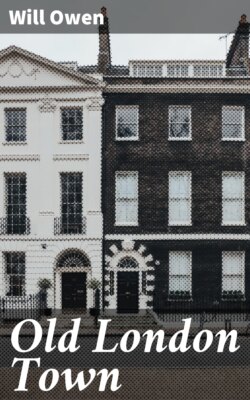Читать книгу Old London Town - Will Owen - Страница 8
На сайте Литреса книга снята с продажи.
ОглавлениеSt. Bartholomew-the-Great
Table of Contents
This fine old Norman relic, the Priory of St. Bartholomew, of which only the choir remains, was founded by one Rahere in the reign of Henry I.
Rahere is said to have been the king's minstrel and jester, a knight of good family and a man of low origin, so we will leave it at that; but there seems to be no doubt that about the year 1120 he began to take life seriously, and undertook a pilgrimage to Rome.
There he was stricken with fever, and vowed that if he were allowed to return safely he would found a hospital for the poor.
During his convalescence he had an extraordinary vision.
A winged, fearsome beast, with eight feet, carried him on high and was about to drop him into a bottomless pit, when a noble form, St. Bartholomew, appeared, disposed of the many-footed one and commanded Rahere to build a church in Smithfield.
The church was founded in 1123, and ten years later the king granted to the Priory a Charter of Privileges.
The charter issued by the king was a thoroughly good one. It was a far, far better one than I have ever known. It enacted that the Priory should have sacc and socc and thol and theme and likewise infogheneteof. It granted liberties, free customs and acquittances within and without and in all places, now and for ever.
It provided also for ferdwit and hegwit, schewigt and fridsoke, forvenge and withfange, and a number of other unconsidered trifles.
The Priory flourished and must have been of a great size, but it suffered at the Dissolution in common with others.
A great portion of the building was removed, as was the case also at the Priory of St. John, both being used to build Somerset House.
There is much of interest to see within the stately interior.
Rahere's tomb with its recumbent effigy under a vaulted canopy is a thing of beauty.
Hogarth, who lived in Bartholomew Close, was baptised here, and the font is still in use.
There are many tablets. One I remember to a long-departed Darby and Joan concluded with these lines:—
"Shee first deceased, Hee for a little Tryd
To live without her, likd it not and dyd."
Until quite recently the north transept had been used for many generations as a blacksmith's forge, while the Lady Chapel was a fringe factory.
The sketch accompanying this narrative is the old gateway entrance from Smithfield, the half-timbered house above having been built in 1590, replacing some monastic buildings which were removed at that time.
The timbered front was covered with plaster, and was only revealed owing to the explosion of a bomb near by during an air raid, when the plaster loosened and fell.
St. Ethelburga's Church.
Table of Contents
